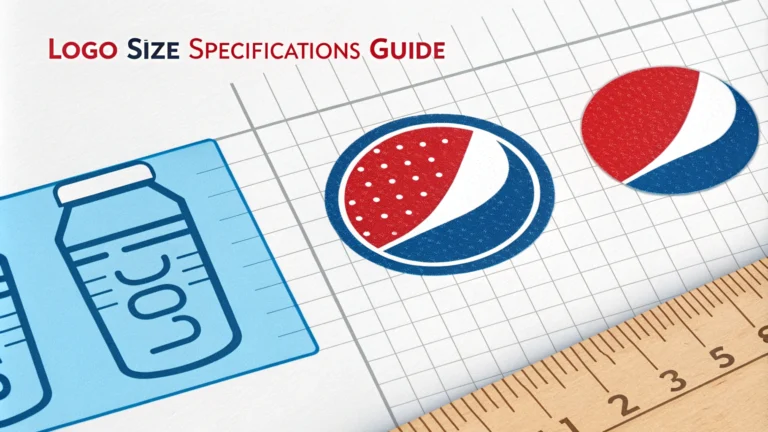A well-designed logo needs proper sizing specifications to maintain its impact and readability across different platforms and materials.
Standard Logo Size Guidelines
- Website Header: 250px × 100px
- Favicon: 16px × 16px or 32px × 32px
- Social Media Profile Pictures:
- Facebook: 180px × 180px
- Twitter: 400px × 400px
- LinkedIn: 300px × 300px
- Instagram: 110px × 110px
Print Materials Specifications
- Business Cards: 1-1.5 inches in height
- Letterhead: 1.5-2 inches in width
- Large Format Printing: Vector format required for scaling
- Merchandise: Minimum 1 inch for small items, scalable for larger products
File Format Requirements
- Vector Files: .ai, .eps, .svg for scalability
- Raster Files: .png, .jpg for web use
- Resolution: 300 DPI minimum for print
A clear space rule of keeping the logo’s height worth of empty space around it helps maintain visual impact.
Common Sizing Mistakes to Avoid
- Stretching or distorting proportions
- Using low-resolution files for printing
- Making logos too complex for small sizes
- Ignoring minimum size requirements
Save your logo in multiple sizes and formats to ensure quick access for different uses.
Quick Size Testing Method
- Print the logo at different sizes
- View on various screens and devices
- Check readability at 1-inch width
- Test favicon visibility
Contact a professional print shop for specific size requirements for specialized materials or unusual printing surfaces.
Logo Size Optimization Tips
- Grid System: Design logos on a grid for better proportion control
- Responsive Design: Create variations for different screen sizes
- Color Versions: Develop monochrome and reverse versions
- Mobile Optimization: Test visibility on small screens
Advanced Specifications
Digital Platforms
- Email Signatures: 100px × 50px
- Mobile Apps: 512px × 512px
- YouTube Channel: 800px × 800px
- Blog Headers: 600px × 200px
Print Applications
- Billboards: Vector format, minimum 300 DPI
- Vehicle Wraps: Scalable vector with bleed area
- Trade Show Displays: High-resolution files with proper scaling
Logo Management Best Practices
- Maintain a central repository of all logo versions
- Document size specifications for different uses
- Create usage guidelines for third parties
- Regular quality checks across platforms
Conclusion
Proper logo sizing is crucial for brand consistency and professional appearance. Maintain a comprehensive set of logo files in various formats and sizes, following platform-specific requirements. Regular testing and updating of logo assets ensures optimal visual presentation across all mediums.
Remember to document all specifications and create clear guidelines for internal teams and external partners to maintain brand integrity across all applications.
FAQs
- What is the minimum recommended size for a logo to maintain legibility?
The minimum recommended size for a logo is typically 1 inch or 2.54 centimeters in width for print materials, and 250 pixels wide for digital use to ensure readability and recognition. - What’s the ideal logo size for social media profile pictures?
LinkedIn requires 400×400 pixels, Facebook uses 170×170 pixels, Twitter needs 400×400 pixels, and Instagram requires 110×110 pixels for profile pictures. - How large should a logo be for business cards?
For standard business cards (3.5 x 2 inches), the logo should typically be between 1 to 1.5 inches in width to maintain proper proportions and visibility. - What resolution should logos be created in for print materials?
Logos for print should be created at 300 DPI (dots per inch) minimum to ensure sharp, clear reproduction in all printed materials. - What’s the recommended logo size for website headers?
Website header logos typically range from 250 to 400 pixels in width, but should not exceed 100 pixels in height to maintain proper website proportions. - What file formats should logos be saved in for different uses?
Vector formats (AI, EPS, SVG) for scalability, PNG for digital use with transparency, JPEG for simple digital applications, and PDF for print materials. - How big should a logo be on a standard letterhead?
On a standard 8.5 x 11 inch letterhead, the logo should typically be between 1.5 to 2.5 inches in width, positioned at the top of the page. - What’s the proper size for email signature logos?
Email signature logos should be between 100-300 pixels in width, with a maximum height of 100 pixels to maintain proper proportions in email clients. - How should logo size vary for different types of signage?
For every 10 feet of viewing distance, increase letter height by 1 inch. For example, if viewing distance is 30 feet, main text elements should be at least 3 inches tall. - What’s the ideal logo size ratio between different branded materials?
Maintain a consistent size ratio of 1:0.75:0.5 between primary applications (signage), secondary applications (letterhead), and tertiary applications (business cards) respectively.








